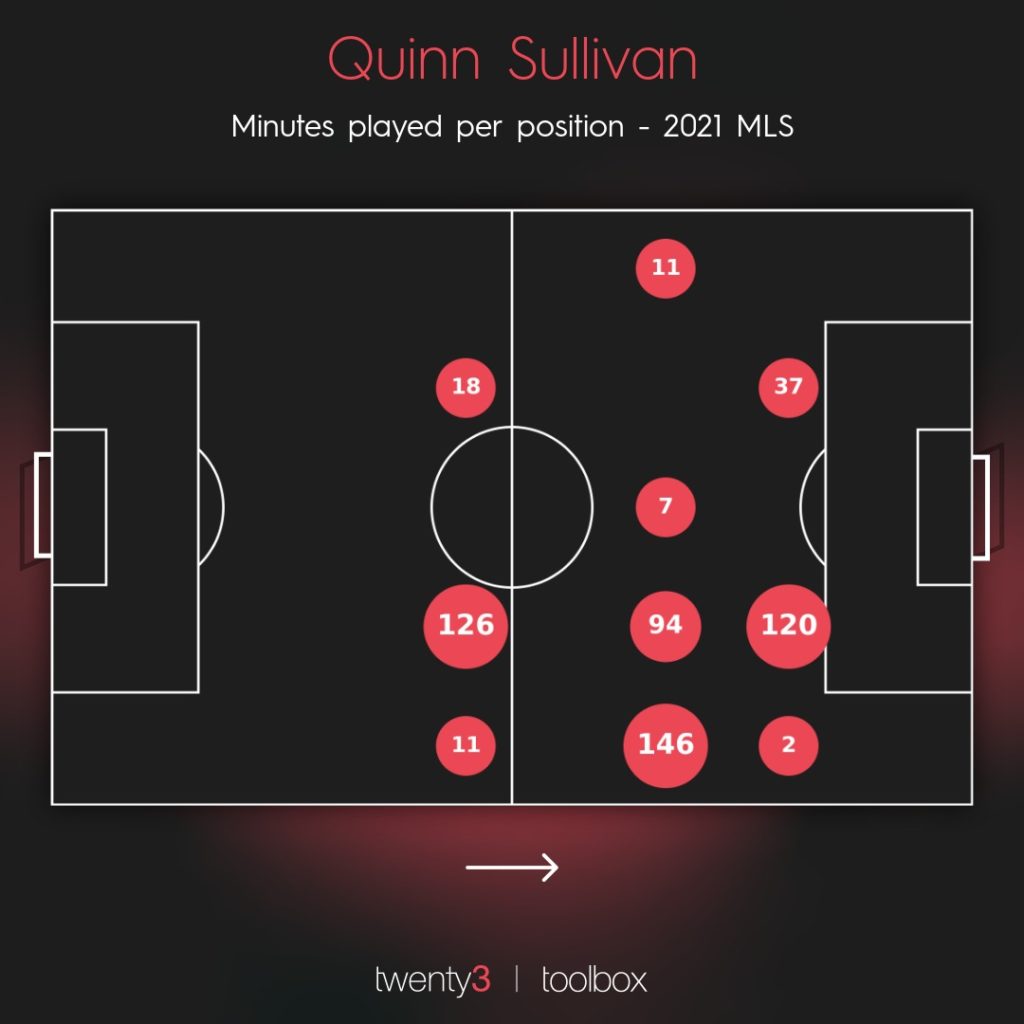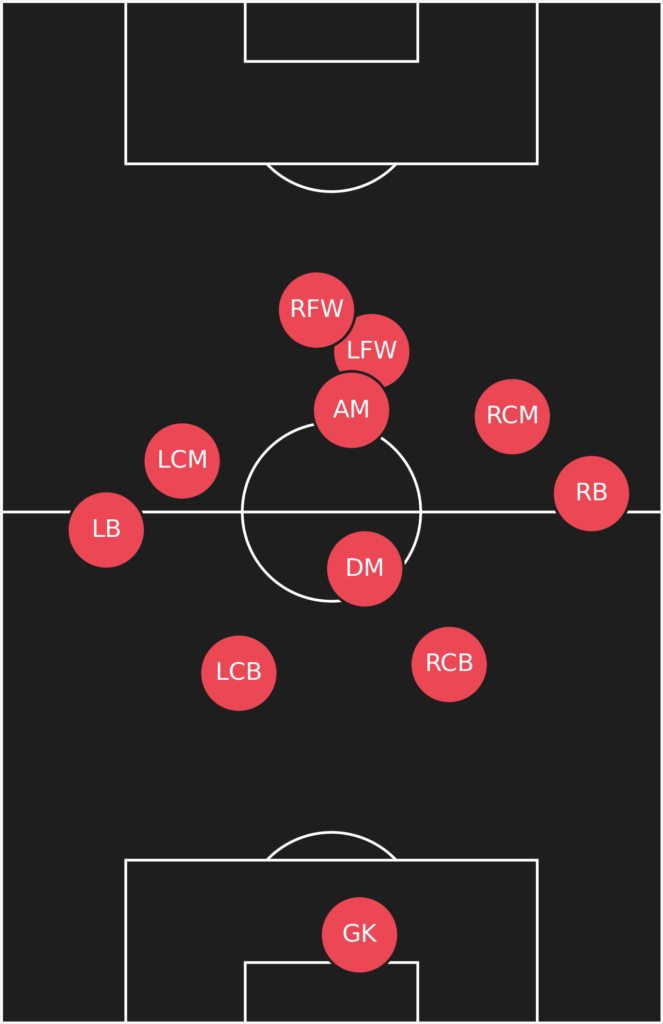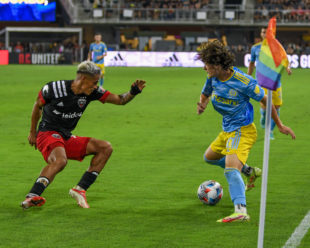Photo: Marjorie Elzey
Guest author James Nalton (Morning Star, World Soccer, Forbes, The Guardian, and more) joins PSP again to discuss the Union’s deep homegrown talent pool ahead of their opener Saturday against Minnesota United.
Major League Soccer may be unpredictable, but one thing you can count on from the Philadelphia Union these days is they will give their extremely talented youth prospects a chance.
A trio of players expected to break through this year — Paxten Aaronson, Jack McGlynn, and Quinn Sullivan — could mean 2022 will be a momentous year for the club’s homegrown program.
Parity is MLS’s superpower
The unpredictability ahead of every MLS campaign means any high hopes in pre-season should come with an air of caution. The league’s changeable nature is one of its attractions, and pundits’ pre-season forecasts can quickly look foolish.
The strength of the Eastern Conference this year — boasting the MLS Cup and Supporters’ Shield winners from the last two seasons, plus the strengthening of squads elsewhere — means it will be an even more keenly contested division in 2022.
In a field of uncertainty, the Union bring a sense of stability and predictability – at least in the way they approach things. The backbone for this is provided by head coach Jim Curtin who, now in his eighth season year as head coach, helps those coming through the academy or arriving from elsewhere settle quickly into the style and rhythm of senior Union football.
From the Academy to the First Team and beyond
Brenden Aaronson and Mark McKenzie have set the standard for those coming through the ranks. Both departed for club-record fees when they left for RB Salzburg and Genk respectively, while former Philly homegrown Auston Trusty also looks likely to end up in Europe – albeit via Colorado Rapids, having agreed a summer move to Arsenal.
The best could still be yet to come.
Brenden’s younger sibling Paxten has long been touted as being the better of the two brothers. Though comparisons in that sense aren’t too helpful, and Paxten will have to do something special if he’s to overtake his older brother’s current trajectory, it’s encouraging that the 18-year-old is talked about as at least being at a similar level at this stage in his development.
Scouts from Europe will be watching Aaronson throughout this season, but other homegrown Union players may also catch their eye. Big things are also predicted for other teenagers McGlynn (18), Sullivan (17), and Brandan Craig (17) to name a few, and the former pair of midfielders, plus Aaronson, could be in for a breakthrough season.
Homegrowns, the transfer market, and putting the pieces together
The Union traded away Jamiro Monteiro ahead of the 2022 season, with the Cape Verde international off to San Jose Earthquakes in return for allocation money and an international slot.
All transfers carry some kind of risk. But, though Monteiro has often been a standout player for the Union and is certainly one of the better playmakers in the league, the emergence of these young players and their potential makes it a risk worth taking.
The acquisition of Daniel Gazdag last season means there is still some international quality in the midfield. While Monterio operated like a midfield version of a No.10 playmaker, Gazdag can also edge more towards the role of a second striker, which potentially leaves space in the team in those midfield roles.
One of the most interesting dynamics this season will be to see how, and indeed if, the trio of Aaronson, McGlynn, and Sullivan can operate in the same lineup.
There are obviously other pieces who can, and in many cases will fit into this midfield puzzle, including Alejandro Bedoya, Leon Flach, Cole Turner, and Jesús Bueno, while José Martínez remains key in the deepest role. But it’s useful for the aforementioned teenage trio that their differences in style mean there is the prospect of them appearing in the same starting XI.
The Union, in shapes and tactics
Tactically, Bedoya is one of the key pieces to the Union’s system. He plays on the right of the diamond midfield but regularly gets into advanced positions, whether wide, through the middle or in between (the half-space).
Sullivan looks like he might be the player most suited to this role which can set Curtin’s version of the 4-4-2 diamond out from other examples of this formation.

As seen in the above image, Sullivan has operated in advanced and wide positions, as well as the central midfield role, making him the ideal backup and potential successor to Bedoya while also being able to fill in elsewhere should the opportunity arise.
The left midfielder in the diamond can also be asked to push forward when given the chance, but as shown in the 2021 average positions graphic below, from Twenty3, they will stay slightly deeper on average than their right-sided counterpart.

McGlynn has operated in this left midfield slot. In the pre-season game against Cincinnati, in which he played the second half, Curtin could be heard shouting from the sidelines: “Get higher Jack McGlynn! Get higher!” McGlynn’s style is more languid-looking than the other two players assessed here. That’s not to say he doesn’t have the requisite work rate, he does, but there’s an obvious air of playmaker about him.
This can mean he has a tendency to go looking for the ball and might drop deep in an attempt to start attacks from the base of midfield. This is a good skill to have and means he may be able to do a job as a playmaker in the deepest midfield role, though he wouldn’t offer as much defensive support as someone like Martinez or potentially Bueno and would need runners either side of him (think Andrea Pirlo at Juventus).
In the position on the left, encouraged to get higher, he’d be able to act as an auxiliary No. 10, just as Bedoya/Sullivan could act as auxiliary strikers/wingers. This should lead to more of a direct impact on the team’s attack closer to the goal, leaving the dynamism to the left-back outside him and the runners inside, with a defensive midfielder providing insurance should the opposition break.
McGlynn’s style and natural playmaking ability mean he could be the most interesting of these three players.
He and Leon Flach could rotate as the left-footers for that left-sided midfield role. The heatmap comparison below shows their differences when playing there, with Flach tending to drift to the wing and McGlynn moving inside to support the No. 10 with playmaking duties.

Playmakers and game-winners
Now on to the player many predict will soon be the star of the show, Paxten Aaronson.
Aaronson should be able to slot into the attacking midfield role at the point of the diamond (No. 10), roaming from a central position to press the opposition out of possession, and finding pockets of space when Union have the ball. His forward runs mean he will occasionally become a support striker, but he also has the awareness and vision to sit in the hole and set up others.
Where Aaronson is involved in the team and how often could depend on how Gazdag is used this season. The Hungarian had a mixed debut campaign but looked to be settling as 2021 wore on and should be able to operate either as the 10 or as a support striker.
There is the possibility he and Aaronson could play in the same XI with Mikael Uhre as the out and out centre forward. But when you add Julián Carranza, Corey Burke and Sérgio Santos to the mix in those central attacking positions, it certainly looks like there will be one No. 10 and two centre forwards.
He also appears to have the attributes and work rate to play either of the other midfield roles on the left or right of the diamond. His heat map also suggests as much.

Getting better, but in a rising tide?
Thanks to the emergence of these impressive young players, there are plenty of options in this Union roster. The question remains how strong it is in comparison to the other teams in the East.
There are few teams with the stability and succession planning of the Union, which means the transfer risks mentioned earlier, including the sales of Monteiro and Kacper Przybylko, should be negated by the sound structure already in place.
Much of the team’s success could depend on the quality and progress of these young players, but they are introduced in such a way that the pressure is eased somewhat by senior first-team regulars and new signings (Bedoya, Gazdag, Martinez, Uhre etc). This can also be seen in the left-back position with Anton Sorenson being backup to Kai Wagner.
Each homegrown has a player in front of them in the lineup, but there are clear opportunities to edge ahead of these players or rotate with them in the starting XI throughout the season. At the same time, these young players are given responsibility and the confidence that comes with that, which helps them progress mentally as well as technically and tactically.
If you can predict anything about the Union in 2022, it’s that these youth players will be given a chance, perhaps initially off the bench, but as the season wears on and players tire and injuries occur, they will get starts.
It could well be the most pleasing and productive season yet for the club’s homegrown project.


Agreed… Can’t wait to get started and host MLS Cup 2022 in Chester.
The ten spot is going to be really interesting to watch this season, because Danail Gazdag is bound to be able to pick up his game after getting a full offseason and having some time to integrate into MLS. Curtin might have to do more lineup juggling than he has in the past, and it’ll be interesting to see.
Some mention has to be given to Nate Harriel as well. Was thrown straight to the sharks in that East Conf final, and acquitted himself like a seasoned player. I’m guessing that performance had something to do with the decision not to re-sign Alvas Powell (who also did well in extended sub duty) or sign a veteran FB.